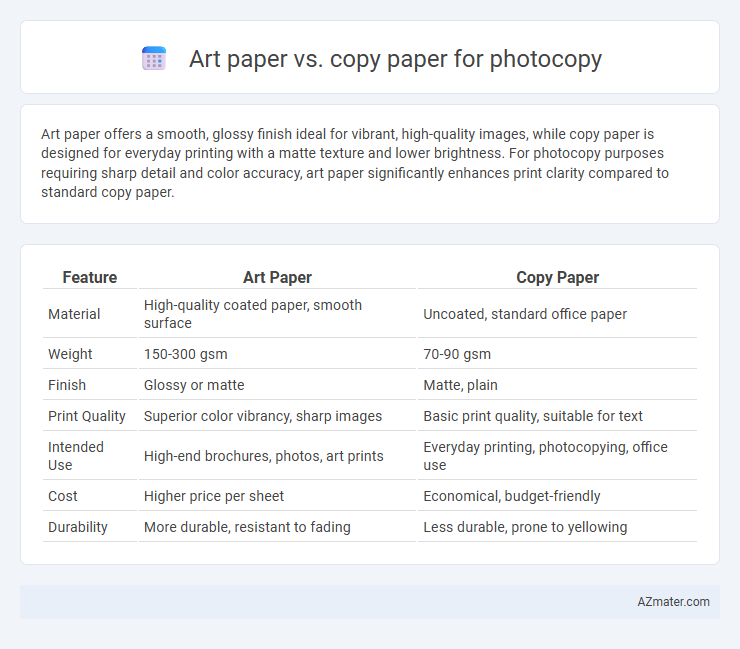Art paper offers a smooth, glossy finish ideal for vibrant, high-quality images, while copy paper is designed for everyday printing with a matte texture and lower brightness. For photocopy purposes requiring sharp detail and color accuracy, art paper significantly enhances print clarity compared to standard copy paper.
Table of Comparison
| Feature | Art Paper | Copy Paper |
|---|---|---|
| Material | High-quality coated paper, smooth surface | Uncoated, standard office paper |
| Weight | 150-300 gsm | 70-90 gsm |
| Finish | Glossy or matte | Matte, plain |
| Print Quality | Superior color vibrancy, sharp images | Basic print quality, suitable for text |
| Intended Use | High-end brochures, photos, art prints | Everyday printing, photocopying, office use |
| Cost | Higher price per sheet | Economical, budget-friendly |
| Durability | More durable, resistant to fading | Less durable, prone to yellowing |
Understanding Art Paper and Copy Paper
Art paper features a smooth, glossy or matte finish with high opacity and excellent ink absorption, making it ideal for printing vibrant images and detailed graphics. Copy paper is typically lightweight, uncoated, and designed for everyday printing and photocopying, offering cost-efficiency and quick drying times but lower image quality. Understanding these differences aids in selecting the right paper for photocopy tasks, ensuring optimal print clarity and durability.
Key Differences Between Art Paper and Copy Paper
Art paper features a smooth, coated surface ideal for high-quality photo printing and vibrant color reproduction, whereas copy paper typically has a rougher, uncoated texture suited for everyday document printing. Art paper is thicker and more durable, enhancing the visual appeal and longevity of prints, while copy paper is thinner and designed for cost-effective mass printing and office use. The key differences lie in coating, thickness, brightness, and intended use, with art paper prioritizing image clarity and copy paper focusing on functionality and affordability.
Texture and Surface Quality Comparison
Art paper features a smooth, coated surface designed to enhance image sharpness and color vibrancy, making it ideal for high-quality photocopies requiring fine detail and glossy finishes. Copy paper has a rougher, uncoated texture that absorbs ink unevenly, resulting in less crisp photocopies with muted color reproduction. The surface quality of art paper reduces ink bleed and smudging, whereas copy paper's porous texture often leads to blurred edges and lower print precision.
Paper Weight and Thickness: What Matters Most?
Art paper typically has a higher paper weight and greater thickness compared to copy paper, which affects durability and print quality in photocopying. The increased density of art paper minimizes ink bleed-through and enhances image sharpness, making it ideal for high-resolution photocopies and presentations. Copy paper, being lighter and thinner, suits everyday documents but may lead to smudging and show-through when used with detailed or double-sided photocopying.
Color Reproduction and Image Clarity
Art paper offers superior color reproduction and image clarity for photocopying due to its smooth, high-quality coating that enhances ink absorption and vibrancy. Copy paper, designed for everyday printing, often leads to duller colors and less sharp images due to its lower brightness and rougher texture. Choosing art paper significantly improves the visual impact of color photocopies, making it ideal for presentations, marketing materials, and high-resolution images.
Cost Analysis: Art Paper vs Copy Paper
Art paper generally costs significantly more than copy paper due to its higher quality, smoother finish, and thicker texture aimed at enhancing image reproduction. Copy paper offers a cost-effective solution for high-volume photocopying, with prices often less than a third of art paper per ream. Choosing between art paper and copy paper should consider budget constraints and desired print quality, balancing cost efficiency with aesthetic requirements.
Best Uses for Art Paper in Photocopying
Art paper offers superior surface texture and thickness compared to copy paper, making it ideal for photocopying high-quality images, artwork, and detailed designs. Its coated finish enhances color vibrancy and sharpness, ensuring that photocopies retain intricate details and rich tones. Art paper is best used for professional presentations, promotional materials, and creative projects where print quality is crucial.
When to Choose Copy Paper for Photocopying
Choose copy paper for photocopying when producing standard, everyday documents that require affordability and smooth feed through most office copiers. Copy paper's lightweight, typically 75-90 gsm, ensures fast drying and minimal smudging, ideal for high-volume printing with basic black-and-white or color ink. It is not recommended for high-quality photo reproductions, where art paper's thicker, coated surface enhances image clarity and vibrancy.
Environmental Impact and Sustainability
Art paper, typically made from higher-quality fibers and often coated, presents challenges in recycling due to its chemical additives, increasing environmental impact compared to copy paper. Copy paper is generally produced with fewer chemicals and is designed for efficient processing in photocopiers, making it more sustainable and easier to recycle. Choosing copy paper over art paper for photocopying reduces waste and supports eco-friendly practices through improved recyclability and lower resource consumption.
Final Verdict: Which Paper is Best for Photocopying?
Art paper offers superior image quality and sharper detail for photocopies due to its smooth texture and brightness, making it ideal for high-resolution documents and graphics. Copy paper, designed for everyday use, ensures reliable performance and affordability with adequate opacity and weight for standard text copying. For typical photocopying needs, copy paper strikes the best balance of cost-efficiency and functionality, while art paper is preferred for presentations requiring enhanced visual fidelity.

Infographic: Art paper vs Copy paper for Photocopy
 azmater.com
azmater.com